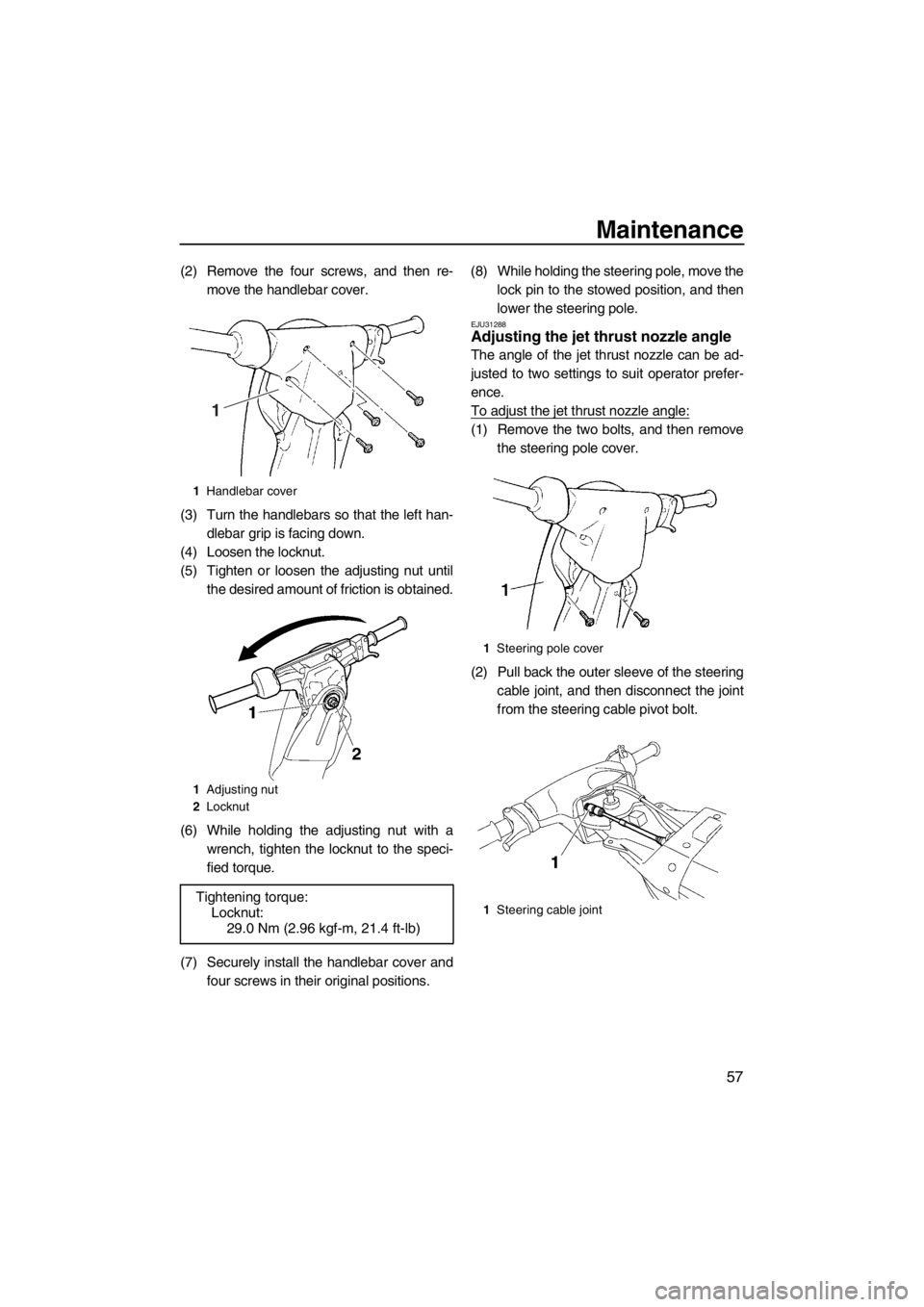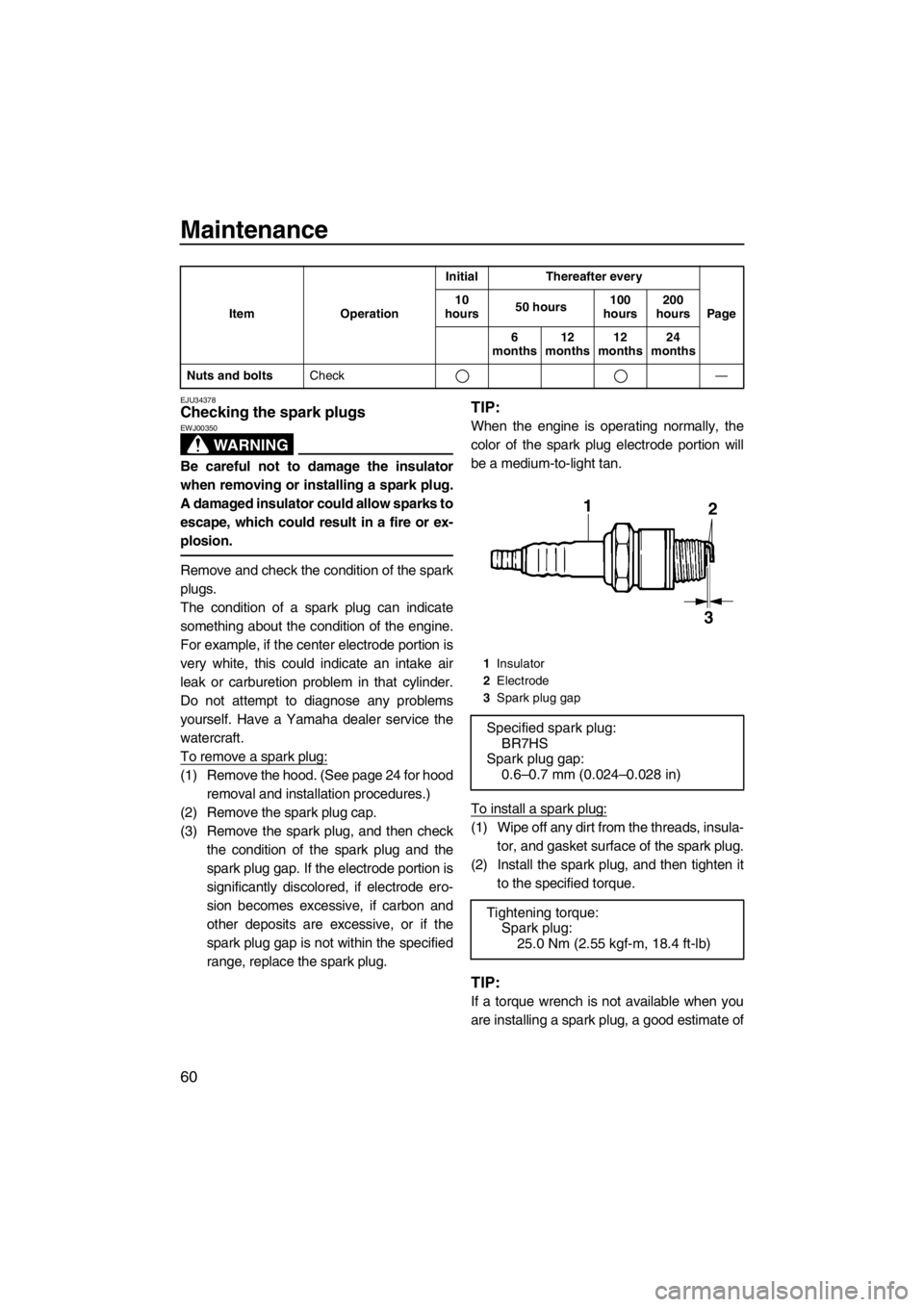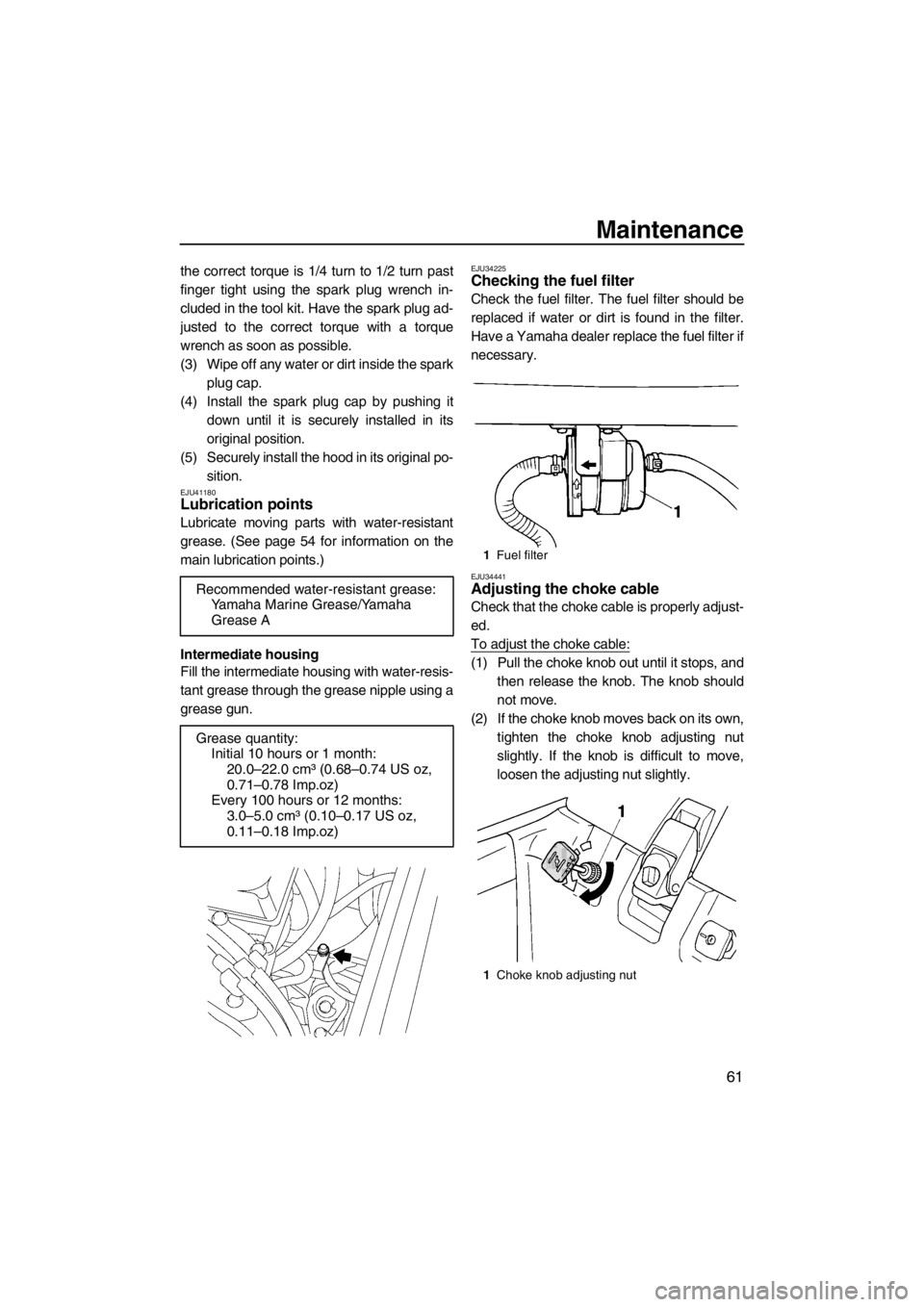Page 63 of 78

Maintenance
57
(2) Remove the four screws, and then re-move the handlebar cover.
(3) Turn the handlebars so that the left han- dlebar grip is facing down.
(4) Loosen the locknut.
(5) Tighten or loosen the adjusting nut until the desired amount of friction is obtained.
(6) While holding the adjusting nut with a wrench, tighten the locknut to the speci-
fied torque.
(7) Securely install the handlebar cover and four screws in their original positions. (8) While holding the steering pole, move the
lock pin to the stowed position, and then
lower the steering pole.
EJU31288Adjusting the jet thrust nozzle angle
The angle of the jet thrust nozzle can be ad-
justed to two settings to suit operator prefer-
ence.
To adjust the jet thrust nozzle angle:
(1) Remove the two bolts, and then removethe steering pole cover.
(2) Pull back the outer sleeve of the steering cable joint, and then disconnect the joint
from the steering cable pivot bolt.
1Handlebar cover
1 Adjusting nut
2 Locknut
Tightening torque:
Locknut:29.0 Nm (2.96 kgf-m, 21.4 ft-lb)
1
1Steering pole cover
1 Steering cable joint
UF2F75E0.book Page 57 Thursday, July 5, 2012 8:50 AM
Page 64 of 78
Maintenance
58
(3) Remove the steering cable pivot bolt.
(4) Select the nozzle angle, install the steer-ing cable pivot bolt with the lock washer in
the desired position (P1 or P2) on the
steering column, and then tighten the bolt
to the specified torque.TIP:
The outermost hole in the steering column
cannot be used.
(5) Securely connect the steering cable jointto the steering cable pivot bolt.
(6) Securely install the steering pole cover and two bolts in their original positions.
1Steering cable pivot bolt
2 Steering column
1Nozzle angles
1 Nozzle angles
2 Steering cable pivot bolt positions
Standard steering cable pivot bolt posi-
tion:
P2
Tightening torque: Steering cable pivot bolt: 5.4 Nm (0.55 kgf-m, 4.0 ft-lb)
UF2F75E0.book Page 58 Thursday, July 5, 2012 8:50 AM
Page 66 of 78

Maintenance
60
EJU34378Checking the spark plugs
WARNING
EWJ00350
Be careful not to damage the insulator
when removing or installing a spark plug.
A damaged insulator could allow sparks to
escape, which could result in a fire or ex-
plosion.
Remove and check the condition of the spark
plugs.
The condition of a spark plug can indicate
something about the condition of the engine.
For example, if the center electrode portion is
very white, this could indicate an intake air
leak or carburetion problem in that cylinder.
Do not attempt to diagnose any problems
yourself. Have a Yamaha dealer service the
watercraft.
To remove a spark plug:
(1) Remove the hood. (See page 24 for hoodremoval and installation procedures.)
(2) Remove the spark plug cap.
(3) Remove the spark plug, and then check the condition of the spark plug and the
spark plug gap. If the electrode portion is
significantly discolored, if electrode ero-
sion becomes excessive, if carbon and
other deposits are excessive, or if the
spark plug gap is not within the specified
range, replace the spark plug.
TIP:
When the engine is operating normally, the
color of the spark plug electrode portion will
be a medium-to-light tan.
To install a spark plug:
(1) Wipe off any dirt from the threads, insula-tor, and gasket surface of the spark plug.
(2) Install the spark plug, and then tighten it to the specified torque.
TIP:
If a torque wrench is not available when you
are installing a spark plug, a good estimate of
Nuts and bolts Check —
Item Operation
Initial Thereafter every
Page
10
hours 50 hours 100
hours 200
hours
6
months 12
months 12
months 24
months
1 Insulator
2 Electrode
3 Spark plug gap
Specified spark plug:
BR7HS
Spark plug gap: 0.6–0.7 mm (0.024–0.028 in)
Tightening torque: Spark plug:
25.0 Nm (2.55 kgf-m, 18.4 ft-lb)
UF2F75E0.book Page 60 Thursday, July 5, 2012 8:50 AM
Page 67 of 78

Maintenance
61
the correct torque is 1/4 turn to 1/2 turn past
finger tight using the spark plug wrench in-
cluded in the tool kit. Have the spark plug ad-
justed to the correct torque with a torque
wrench as soon as possible.
(3) Wipe off any water or dirt inside the sparkplug cap.
(4) Install the spark plug cap by pushing it down until it is securely installed in its
original position.
(5) Securely install the hood in its original po- sition.
EJU41180Lubrication points
Lubricate moving parts with water-resistant
grease. (See page 54 for information on the
main lubrication points.)
Intermediate housing
Fill the intermediate housing with water-resis-
tant grease through the grease nipple using a
grease gun.
EJU34225Checking the fuel filter
Check the fuel filter. The fuel filter should be
replaced if water or dirt is found in the filter.
Have a Yamaha dealer replace the fuel filter if
necessary.
EJU34441Adjusting the choke cable
Check that the choke cable is properly adjust-
ed.
To adjust the choke cable:
(1) Pull the choke knob out until it stops, andthen release the knob. The knob should
not move.
(2) If the choke knob moves back on its own, tighten the choke knob adjusting nut
slightly. If the knob is difficult to move,
loosen the adjusting nut slightly.
Recommended water-resistant grease:
Yamaha Marine Grease/Yamaha
Grease A
Grease quantity: Initial 10 hours or 1 month:
20.0–22.0 cm³ (0.68–0.74 US oz,
0.71–0.78 Imp.oz)
Every 100 hours or 12 months:
3.0–5.0 cm³ (0.10–0.17 US oz,
0.11–0.18 Imp.oz)
1Fuel filter
1 Choke knob adjusting nut
UF2F75E0.book Page 61 Thursday, July 5, 2012 8:50 AM